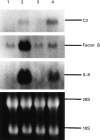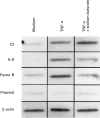Counter-regulatory effect of sodium butyrate on tumour necrosis factor-alpha (TNF-alpha)-induced complement C3 and factor B biosynthesis in human intestinal epithelial cells
- PMID: 10540155
- PMCID: PMC1905403
- DOI: 10.1046/j.1365-2249.1999.01038.x
Counter-regulatory effect of sodium butyrate on tumour necrosis factor-alpha (TNF-alpha)-induced complement C3 and factor B biosynthesis in human intestinal epithelial cells
Abstract
The various biological activities of butyrate have been well documented. In this study, we tested the effects of butyrate on TNF-alpha-induced complement C3 and factor B biosynthesis in human intestinal epithelial cells. The biosynthesis of C3, factor B and IL-8 was evaluated at the protein and mRNA levels. To evaluate transcriptional activation, the nuclear run-on assay was performed. The transcription factor-DNA binding activity was assessed by an electrophoretic gel mobility shift assay (EMSA). In the intestinal epithelial cell lines HT-29, T84 and Caco-2, sodium butyrate enhanced TNF-alpha-induced C3 secretion, but suppressed TNF-alpha-induced factor B and IL-8 secretion. Nuclear run-on assay revealed that transcriptional regulatory mechanisms are involved in the effects of sodium butyrate. The EMSAs indicated that sodium butyrate suppressed TNF-alpha-induced nuclear factor (NF)-kappaB- and activation protein (AP)-1-DNA binding activity, but enhanced TNF-alpha-induced activation of CCAAT/enhancer-binding protein (C/EBP)beta (NF-IL-6)-DNA binding activity. Sodium butyrate induced a counter-regulatory effect on TNF-alpha-induced C3 and factor B biosynthesis in human intestinal epithelial cells. Butyrate action has been discussed with its activity to induce histone hyperacetylation, but its counter-regulatory effect on complement biosynthesis may be closely associated with the modulation of transcription factor activation.
Figures






References
-
- Vassalli P. The pathophysiology of tumor necrosis factors. Annu Rev Immunol. 1992:411–52. - PubMed
-
- Braegger CP, Nicholls SW, Murch SH, et al. Tumor necrosis factor alpha in stool as a marker of intestinal inflammation. Lancet. 1992;339:89–91. - PubMed
-
- Breese EJ, Michte CA, Nicholls SW, et al. Tumor necrosis factor α-producing cells in the intestinal mucosa of children with inflammatory bowel disease. Gastroenterology. 1994;106:1455–66. - PubMed
-
- Morgan BP. The complement system. In: Morgan BP, editor. Complement: clinical aspects and relevance to disease. London: Academic Press; 1990. pp. 1–35.
Publication types
MeSH terms
Substances
LinkOut - more resources
Full Text Sources
Medical
Miscellaneous

